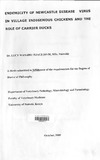| dc.description.abstract | While the epidemiology of Newcastle disease (ND) in commercial poultry systems is very well documented, the ecology of this disease in indigenous birds, especially in tropical environments, is not adequately reported. This thesis covers work carried out to investigate the ecological and biological factors that are associated with NDV endemicity in local indigenous chickens in wet and dry areas. The results led to the development of the elements of an endemicity model. Three on-farm studies were done, namely: (1) Establishing factors associated with ND disease outbreaks in chickens for five different agro-ecological zones; (2) Establishing ND virus prevalence in chickens in these zones; and (3) Establishing the role of serum and egg-yolk antibodies as indicators of ND carrier status in chickens. The first study was carried out by interviewing 15 farmers from each zone using questionnaires. Samples were collected from chicken for viral isolation and serology from the respective farmer’s flocks for the second and third studies.
Controlled studies were then designed to investigate whether a stress model can explain the dynamics of Newcastle disease virus (NDV) ecology in the duck - chicken transmission interactions. Stress was simulated by injecting birds with dexamethazone to induce immunosuppression (IS). The study design comprised experiments 4 -7, namely: (4) Cross-transmission studies between infected ducks and sentinel chickens; (5) Studies establishing the types of pathological lesions in NDV carrier ducks, (6) Determination of NDV antigen localization in various tissues of experimental ducks; and (7) Determination of persistence of the virus in experimental ducks with various levels of NDV antibodies. Various groups of NDV - seronegative ducks, raised at the university premises, were used in the four experiments. In experiment 4, five IS-infected, five non-IS-infected and five naive ducks were each mixed with five naive chickens. In experiment five, 38 IS- infected, 37 non-IS infected ducks were investigated for pathological lesions and compared with respective control ducks that were penned separately. In experiment six, 23 IS-infected ducks and 22 non-IS infected ducks were tested for the location of the viral antigen and compared with 10 naive ducks that were separately penned. In Experiment seven, 94 ducks were divided into 3 groups according to antibody status [low antibody (32), medium antibody (32) and antibody free (30)]. Each duck group had four sub-groups namely IS-infected; IS-non-infected and two respective controls. Each experiment had 12 non - IS infected chickens as positive controls. | |


